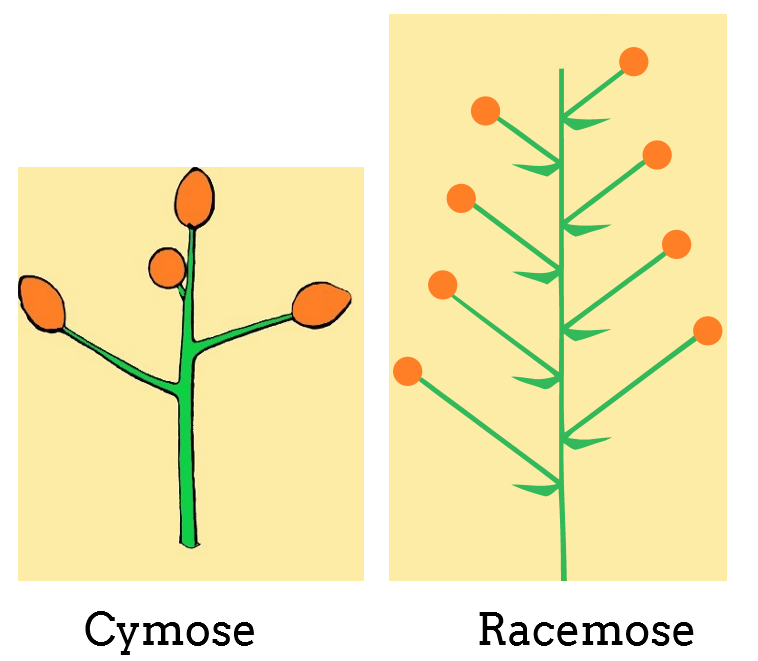
In an inflorescence where flowers are grown laterally in acropetal succession, the position of the youngest floral bud shall be
(a)Proximal
(b)Distal
(c)Intercalary
(d)Anywhere
Answer
499.2k+ views
2 likes
Hint: In acropetal succession, the stem keeps growing and does not terminate. This type of inflorescence is also known as ‘Racemose inflorescence'.
Complete answer:
Acropetal succession in a plant is defined as the growth of the floral component from base to the apex. This means that in an inflorescence acquiring acropetal succession, the youngest floral bud shall occupy the distal position or the apex while the older flowers will lie proximal to the stem i.e. towards the base.
Consequently, the newly formed fruit remains uncovered. Example- mustard, radish, snapdragon, wheat, barley, etc. Types of racemose inflorescence include Raceme, Spike, Spikelet, Panicle, Catkin, Spadix, Corymb, and Umbel.
Basipetal succession- The growth of the inflorescence where the stem terminates into an apical flower is known as basipetal succession. It is also known as Cymose inflorescence. Hence, the newer flowers lie proximal or close to the stem base while the older flowers lie distally. It is seen in drosera, dianthus, calotropis, hibiscus, etc.
So, the correct answer is ‘Distal’.
Note: -Spikelet type of inflorescence is the characteristic feature of the Poaceae or the Gramineae family that consists of grasses.
-The central longitudinal axis of the inflorescence is known as Rachis and the stem holding all the branches is known as Peduncle.
-The racemose and cymose inflorescence is known as the open and closed type of inflorescence respectively.

Complete answer:
Acropetal succession in a plant is defined as the growth of the floral component from base to the apex. This means that in an inflorescence acquiring acropetal succession, the youngest floral bud shall occupy the distal position or the apex while the older flowers will lie proximal to the stem i.e. towards the base.
Consequently, the newly formed fruit remains uncovered. Example- mustard, radish, snapdragon, wheat, barley, etc. Types of racemose inflorescence include Raceme, Spike, Spikelet, Panicle, Catkin, Spadix, Corymb, and Umbel.
Basipetal succession- The growth of the inflorescence where the stem terminates into an apical flower is known as basipetal succession. It is also known as Cymose inflorescence. Hence, the newer flowers lie proximal or close to the stem base while the older flowers lie distally. It is seen in drosera, dianthus, calotropis, hibiscus, etc.
So, the correct answer is ‘Distal’.
Note: -Spikelet type of inflorescence is the characteristic feature of the Poaceae or the Gramineae family that consists of grasses.
-The central longitudinal axis of the inflorescence is known as Rachis and the stem holding all the branches is known as Peduncle.
-The racemose and cymose inflorescence is known as the open and closed type of inflorescence respectively.

Latest Vedantu courses for you
Grade 10 | CBSE | SCHOOL | English
Vedantu 10 CBSE Pro Course - (2025-26)
School Full course for CBSE students
₹37,300 per year
Recently Updated Pages
Master Class 11 Economics: Engaging Questions & Answers for Success

Master Class 11 Business Studies: Engaging Questions & Answers for Success

Master Class 11 Accountancy: Engaging Questions & Answers for Success

Master Class 11 English: Engaging Questions & Answers for Success

Master Class 11 Computer Science: Engaging Questions & Answers for Success

Master Class 11 Maths: Engaging Questions & Answers for Success

Trending doubts
State and prove Bernoullis theorem class 11 physics CBSE

1 ton equals to A 100 kg B 1000 kg C 10 kg D 10000 class 11 physics CBSE

State the laws of reflection of light

One Metric ton is equal to kg A 10000 B 1000 C 100 class 11 physics CBSE

Difference Between Prokaryotic Cells and Eukaryotic Cells

1 Quintal is equal to a 110 kg b 10 kg c 100kg d 1000 class 11 physics CBSE




